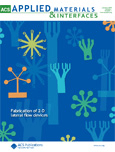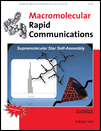
Gels
Scope & Guideline
Innovating the Future of Gel Science
Introduction
Aims and Scopes
- Synthesis and Characterization of Gels:
The journal publishes studies on the various methods for synthesizing gels, including chemical, physical, and biological approaches. Characterization techniques such as rheology, spectroscopy, and microscopy are emphasized to understand the properties and behaviors of gels. - Biomedical Applications of Gels:
A significant focus is placed on the use of gels in biomedical applications, including drug delivery systems, wound healing, tissue engineering, and regenerative medicine. Research often explores how gel properties can be tailored for specific therapeutic outcomes. - Environmental Applications:
Research addressing the use of gels for environmental remediation, including wastewater treatment and pollutant adsorption, is frequently highlighted. This includes studies on how hydrogels can effectively remove heavy metals and organic dyes from contaminated water. - Food Science and Technology:
The journal covers the application of gels in food science, focusing on their role as thickeners, stabilizers, and delivery systems for bioactive compounds. Emphasis is placed on the development of edible gels and their interactions with food components. - Smart and Responsive Gels:
The journal features research on stimuli-responsive gels, which can change their properties in response to environmental triggers such as pH, temperature, or light. These smart gels are of particular interest for drug delivery and adaptive materials. - Nanotechnology in Gels:
The incorporation of nanomaterials into gel systems for enhanced properties and functionalities is a growing research area. This includes studies on nanogels and their applications in drug delivery, diagnostics, and sensor technologies.
Trending and Emerging
- Biocompatible and Bioactive Gels:
There is a growing interest in biocompatible and bioactive gels designed for biomedical applications. Research is increasingly focused on developing gels that promote cellular interactions, support tissue growth, and enhance drug delivery efficacy. - Smart Hydrogels for Drug Delivery:
Smart hydrogels that respond to environmental stimuli are gaining traction. Research is centered on developing hydrogels that can release drugs in a controlled manner based on changes in temperature, pH, or light exposure, allowing for more targeted therapies. - Sustainable and Green Gel Technologies:
Emerging research is focusing on sustainable and environmentally friendly gel formulations. This includes the use of natural polymers and biodegradable materials to create gels that minimize environmental impact. - Nanogel Systems in Drug Delivery:
Nanogels are becoming a prominent area of research within the journal. These systems combine the properties of gels with nanotechnology, resulting in improved drug delivery mechanisms and enhanced therapeutic outcomes. - Hydrogels for Environmental Remediation:
Research on using hydrogels for environmental applications, particularly in wastewater treatment and pollutant removal, is on the rise. This trend reflects the increasing emphasis on addressing environmental challenges through innovative gel technologies. - 3D Printing and Hydrogel Applications:
The integration of 3D printing technology with hydrogels is a rapidly growing field. Research focuses on creating complex structures for tissue engineering and regenerative medicine, allowing for precise control over scaffold architecture and functionality.
Declining or Waning
- Traditional Gel Applications:
Research focusing solely on traditional gel applications, such as basic food thickeners or simple drug delivery systems, has seen a decline. There is a noticeable shift towards more complex and multifunctional gel systems that incorporate advanced materials and technologies. - Single-Component Gels:
Studies centered around single-component gels are becoming less common. There is a growing preference for hybrid or composite gel systems that offer enhanced properties and functionalities compared to traditional single-component approaches. - Conventional Synthesis Methods:
The exploration of conventional gel synthesis methods is waning in favor of more innovative and sustainable approaches. Researchers are increasingly focusing on green chemistry and environmentally friendly synthesis techniques. - Basic Characterization Techniques:
While characterization remains crucial, there is a shift towards more advanced and multidisciplinary characterization methods. Basic techniques may be less emphasized as researchers seek comprehensive insights into gel properties.
Similar Journals

ACS Applied Materials & Interfaces
Pioneering Innovations in Nanotechnology and MedicineACS Applied Materials & Interfaces, published by the American Chemical Society, stands as a leading journal in the field of applied materials, nanotechnology, and interdisciplinary research in medicine. With an impressive Impact Factor that places it in the Q1 category across Materials Science, Medicine, and Nanoscience and Nanotechnology, this journal consistently ranks among the top tier, evidencing its significance and influence in advancing scientific knowledge. The journal’s scopus ranking of 33 out of 463 in General Materials Science further underscores its critical role in disseminating innovative and high-quality research. Although it is not an open-access journal, a diverse range of access options is available, ensuring that vital research findings are accessible to a broad audience of researchers, professionals, and students. Targeting breakthroughs in the synthesis, characterization, and application of materials and interfaces, ACS Applied Materials & Interfaces serves as a pivotal platform for publishing cutting-edge studies essential for future technological advancements.

ACS Materials Au
Exploring the Frontiers of Materials ScienceACS Materials Au, published by the American Chemical Society, is a premier open-access journal that has been at the forefront of materials science since its inception in 2021. With an ISSN of 2694-2461, this journal encompasses an expansive range of topics including biomaterials, electronic, optical and magnetic materials, materials chemistry, and polymers and plastics, consistently achieving Q1 rankings in these categories for 2023. The journal is based in the United States and operates from the AMS's headquarters in Washington, DC, offering significant visibility and a robust platform for researchers. The journal's commitment to open access ensures wide dissemination of groundbreaking research, enabling a diverse audience—including researchers, professionals, and students—to engage with the latest advancements in materials science. With an encouraging impact factor and a focus on novel materials and innovative applications, ACS Materials Au stands as a vital resource for anyone devoted to understanding and advancing the frontiers of materials engineering and science.

CURRENT OPINION IN COLLOID & INTERFACE SCIENCE
Driving Knowledge in Colloid and Surface InteractionsCURRENT OPINION IN COLLOID & INTERFACE SCIENCE, published by Elsevier Science London, serves as a premier platform for researchers and professionals in the field of colloid, interface science, and related disciplines. With an impressive Q1 ranking in multiple categories including Colloid and Surface Chemistry, Physical and Theoretical Chemistry, Polymers and Plastics, as well as Surfaces and Interfaces, this journal showcases cutting-edge developments and expert opinions that drive innovation in these areas. As a leader in its field, it maintains robust academic standards, reflected in its high percentile rankings across various Scopus categories, such as 3rd in Surfaces and Interfaces and 10th in Physical and Theoretical Chemistry. While the journal is not Open Access, it provides valuable insights to a wide audience, making it an essential resource for advancing knowledge and fostering collaborations among researchers, academics, and industry professionals alike. With a continual publication timeline extending from 1996 to 2024, it captures the evolving landscape of colloid and interface science, ensuring that readers are equipped with the latest findings and perspectives.

Carbohydrate Polymer Technologies and Applications
Advancing the Frontiers of Carbohydrate Polymer ResearchCarbohydrate Polymer Technologies and Applications, published by ELSEVIER, is an esteemed open access journal that has been fostering innovation in the field of carbohydrate polymer research since its inception in 2020. With its ISSN 2666-8939, this journal is dedicated to exploring the intersections of analytical chemistry, biochemistry, biotechnology, and materials science, making significant contributions to our understanding of carbohydrate polymers and their diverse applications across various industries. Notably, it has attained a prominent position in various categories, reflecting its quality and impact: ranked Q1 in Analytical Chemistry, Biotechnology, and several Materials Science disciplines, while maintaining strong positions in the Q2 and other quartiles. Additionally, with impressive Scopus rankings—14th in Chemistry (miscellaneous) and 23rd in Analytical Chemistry—it stands at the forefront of scholarly dialogue in these areas, appealing to researchers, professionals, and students alike. The journal's commitment to open access facilitates wider dissemination of knowledge and enhances collaborative research, solidifying its role as a pivotal resource for advancing carbohydrate polymer technologies.

ADVANCES IN COLLOID AND INTERFACE SCIENCE
Innovating Insights in Colloidal SystemsADVANCES IN COLLOID AND INTERFACE SCIENCE, published by Elsevier, stands as a premier journal in the disciplines of colloid and interface science, with an esteemed impact factor reflecting its influential research contributions. As a leader in its field, it holds an impressive Q1 ranking across multiple categories, including Colloid and Surface Chemistry, Physical and Theoretical Chemistry, as well as Surfaces and Interfaces. Established in 1967 and continuing its legacy through 2024, the journal provides a vital platform for dissemination of innovative findings and techniques in colloidal systems and interfacial phenomena. Researchers and professionals engaged in these areas will find a wealth of insights and advancements, given its high percentile rankings in Scopus that underscore its significance in both chemistry and physics. While the journal maintains a subscription-based model, it remains an essential resource for anyone looking to deepen their understanding of the complex interactions defining modern materials science.

MACROMOLECULAR BIOSCIENCE
Advancing the Frontiers of Macromolecular InnovationMACROMOLECULAR BIOSCIENCE, published by WILEY-V C H VERLAG GMBH, is a leading journal in the fields of bioengineering, biomaterials, biotechnology, materials chemistry, and polymers and plastics. With a convergence of scientific inquiry since its inception in 2001, the journal has established itself as a vital resource for researchers and professionals exploring the interface of molecular sciences and biosystems. It boasts impressive Scopus rankings, including Q1 status in multiple categories, reflecting its significant contribution to advancing knowledge and innovation in the polymer and biomaterials domains. While the journal does not currently offer open access options, its rigorous peer-review process ensures the publication of high-quality research that fuels academic discourse. Positioned in Weinheim, Germany, MACROMOLECULAR BIOSCIENCE aims to bridge theoretical understanding with practical applications, making it an essential reference for students, academics, and industry practitioners dedicated to the evolving landscape of macromolecular bioscience.

Materials Today Bio
Advancing the frontier of bioengineering and biomaterials.Materials Today Bio, published by Elsevier, is an esteemed open-access journal dedicated to advancing the fields of bioengineering, biomaterials, and biomedical engineering. Since its inception in 2019, this journal has quickly made a name for itself, currently ranked Q1 in multiple categories including Bioengineering, Biomaterials, and Biotechnology, reflecting its exceptional quality and relevance in the rapidly evolving landscape of bio-related sciences. With an impressive Scopus ranking positioning it in the top 25% of its categories, Materials Today Bio provides a vital platform for researchers and professionals to share cutting-edge discoveries and innovative applications that bridge the gap between materials science and biological studies. Accessible to a global audience, this journal not only fosters collaboration among the scientific community but also aims to highlight significant advancements in cell and molecular biology, making it an indispensable resource for students and seasoned experts alike. The journal's commitment to open access since 2019 underscores its dedication to disseminating knowledge widely, ensuring that crucial findings reach those who can benefit from them the most.

MACROMOLECULAR RAPID COMMUNICATIONS
Fostering Collaboration through Swift Scientific CommunicationMACROMOLECULAR RAPID COMMUNICATIONS, published by WILEY-V C H VERLAG GMBH in Germany, is an esteemed journal dedicated to the rapid dissemination of high-quality research in the fields of materials chemistry, organic chemistry, and polymers and plastics. With a remarkable 2023 impact factor securing its place in the prestigious Q1 category across three key disciplines, the journal ranks impressively within the top quartiles of the Scopus metrics, standing at 36th in organic chemistry and 35th in polymers and plastics. Although the journal does not offer open access options, its informative depth and innovative research make it an invaluable resource for researchers, professionals, and students seeking to stay abreast of the latest developments in macromolecular science. Covering a broad spectrum of topics from fundamental research to applications, MACROMOLECULAR RAPID COMMUNICATIONS aims to foster collaboration and inspire further advancements within the scientific community.

Polysaccharides
Exploring the Frontier of Polysaccharide ResearchPolysaccharides is a leading academic journal published by MDPI, specializing in the interdisciplinary field of polysaccharide research. Since its inception in 2020, this Open Access journal aims to facilitate the dissemination of groundbreaking research in materials science, chemistry, and engineering. With an impressive ranking among the top-tier journals—holding the 29th position in Engineering, the 20th in Chemistry, and the 42nd in Materials Science according to Scopus—it offers a significant platform for researchers and professionals seeking to enrich their understanding of polysaccharides' properties, applications, and innovations. The journal welcomes contributions that advance knowledge in polysaccharide chemistry, structural analysis, and various applications in pharmaceuticals, food sciences, and biomaterials. Located in the heart of Basel, Switzerland, Polysaccharides is poised to be a critical resource for anyone looking to stay at the forefront of polysaccharide research and applications, with publications openly accessible to a global audience.

Progress in Biomaterials
Connecting Researchers to Shape the Future of BiomaterialsProgress in Biomaterials is a premier journal published by Springer Heidelberg, dedicated to advancing the field of biomaterials through the dissemination of high-quality research articles, reviews, and case studies. The journal, with an ISSN of 2194-0509 and an E-ISSN of 2194-0517, holds an esteemed position within both the Biomaterials and Chemical Engineering fields, as evidenced by its rankings in the Q2 and Q1 quartiles, respectively. With its convergence over the years from 2013 to 2023, it has maintained a strong impact on scientific discourse, ranking #15 in Chemical Engineering and #30 in Biomaterials according to Scopus metrics. The journal is based in Heidelberg, Germany, and aims to provide an open platform for interdisciplinary collaboration amongst researchers, professionals, and students alike, fostering innovation and progress in biomaterials research. As a crucial resource for those engaged in this dynamic field, it empowers authors and readers to explore the latest trends, technologies, and applications in biomaterials development.